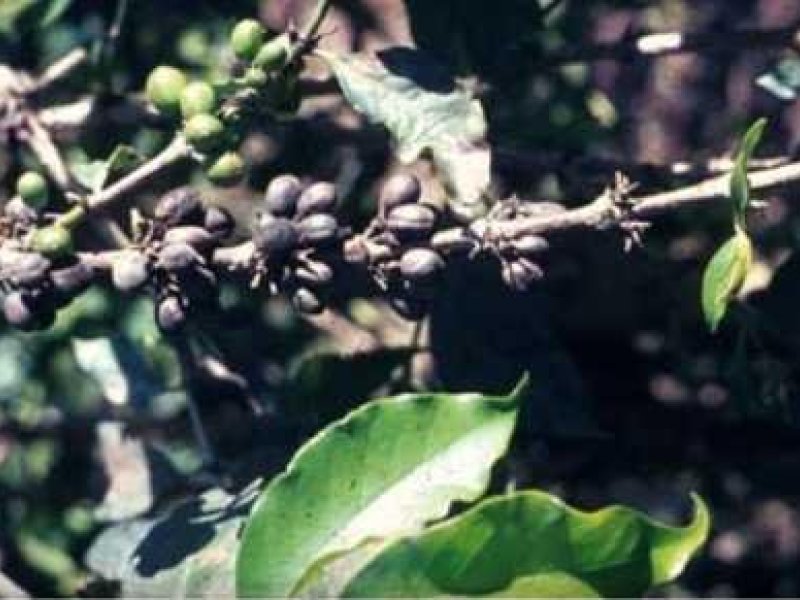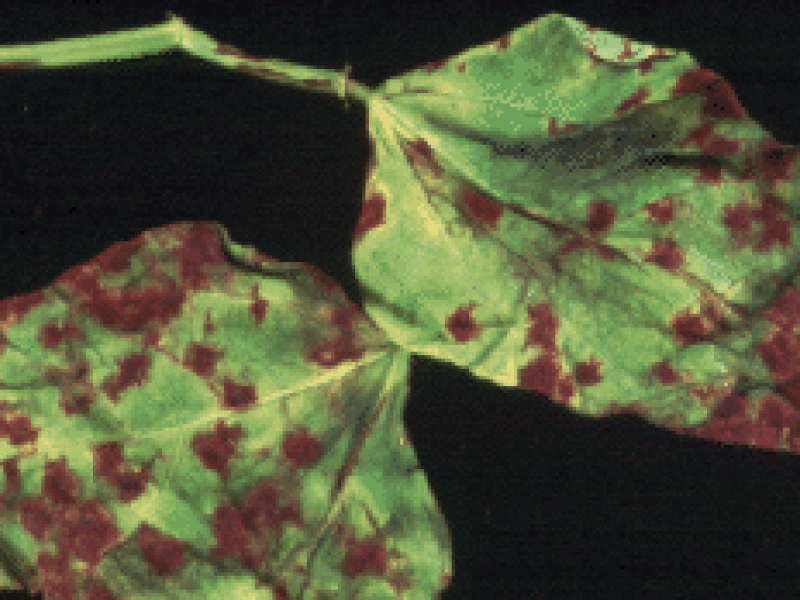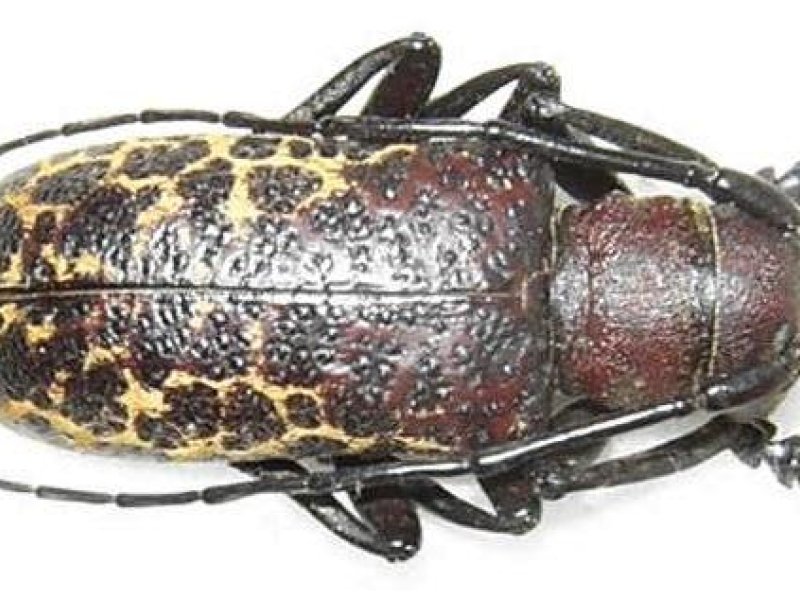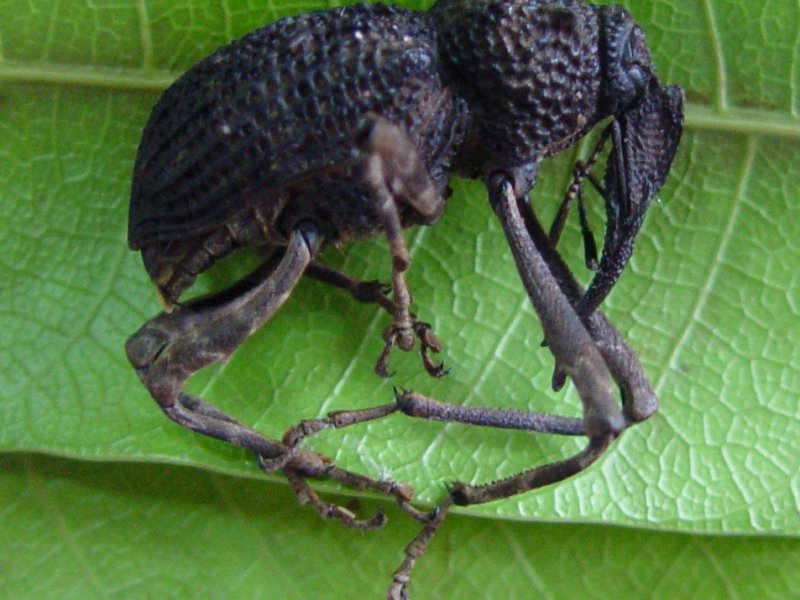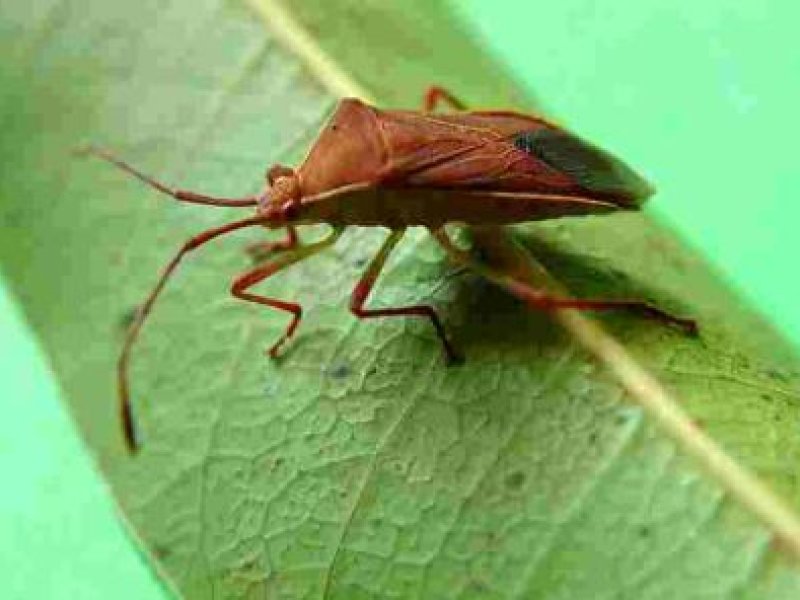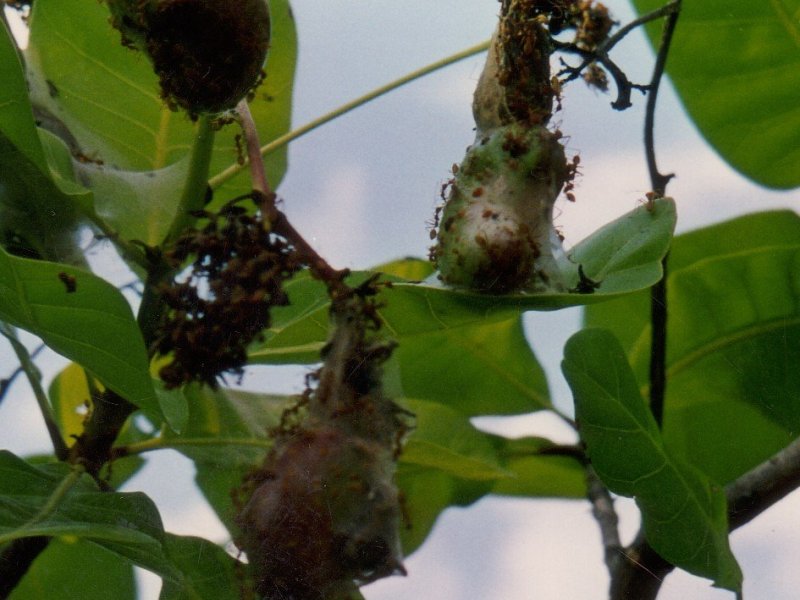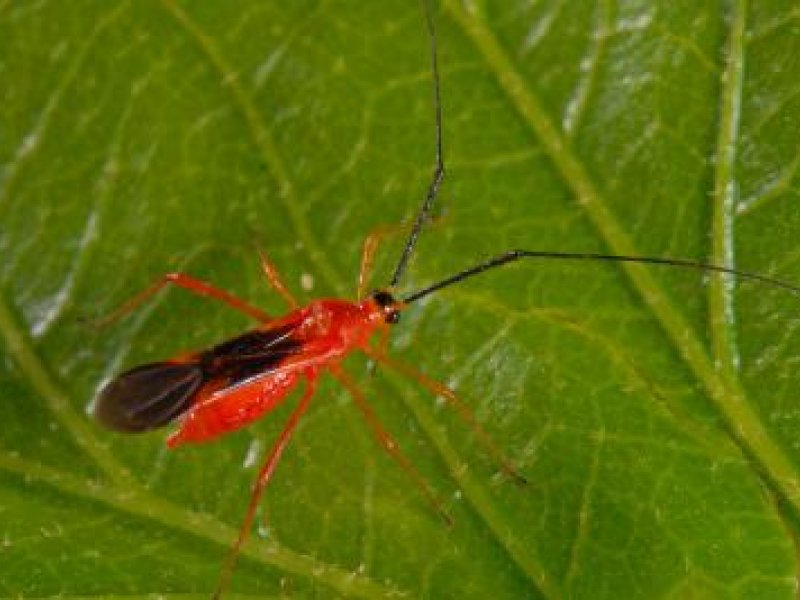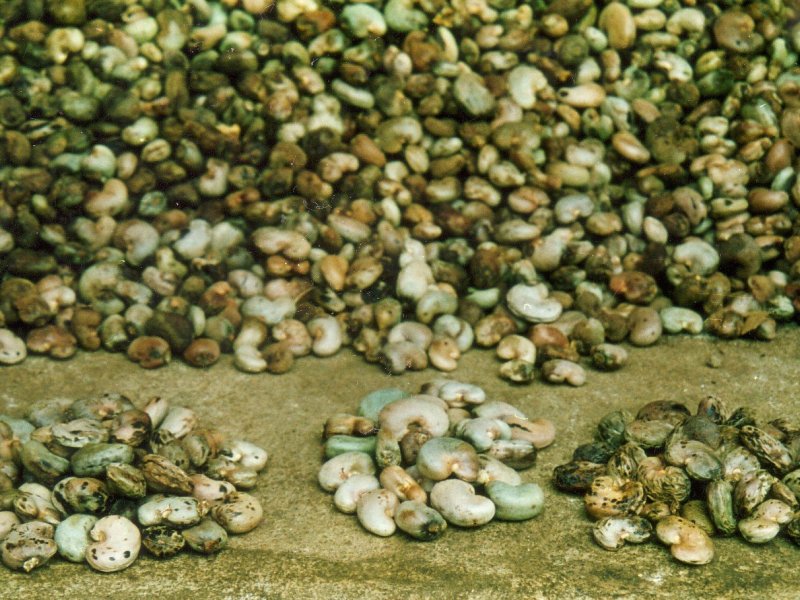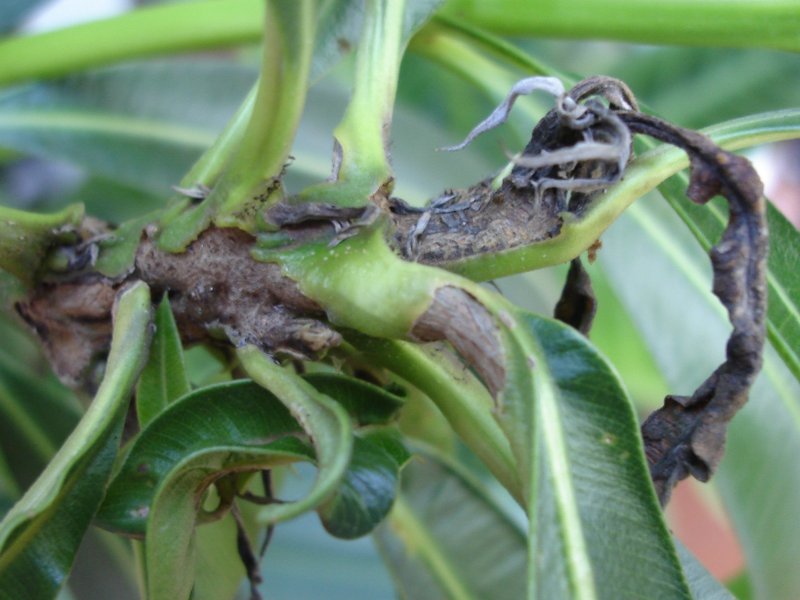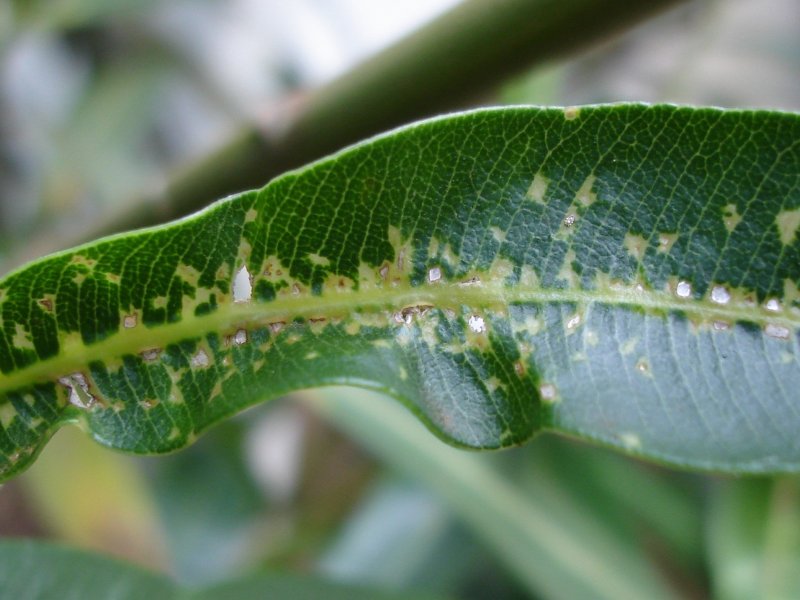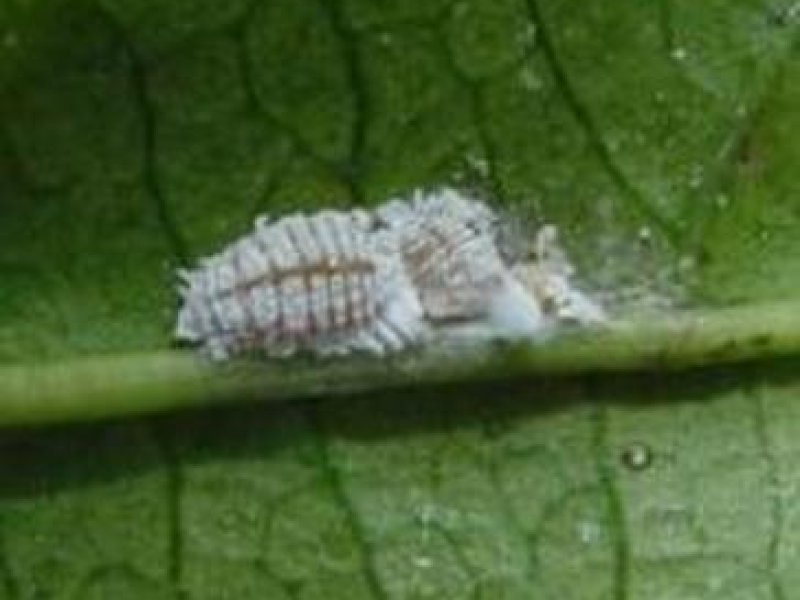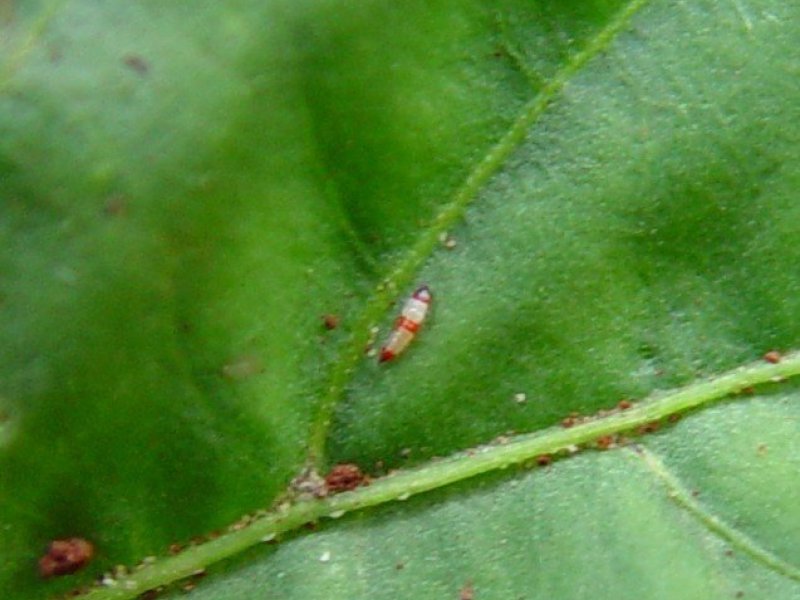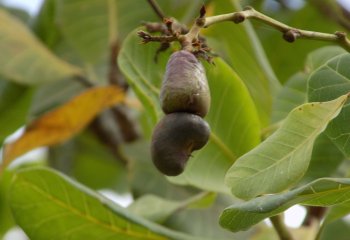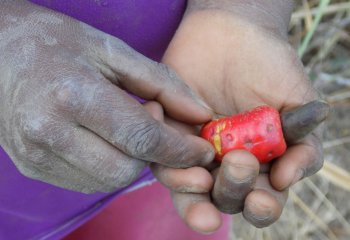|
Anthracnose Colletotrichum gloeosporioides The disease attacks young plant tissues and can cause severe crop loss when it infects flowers, which turn black and die. Young leaves, cashew apples and nuts are similarly affected. Infected young terminal shoots die back. The disease is promoted by warm, damp conditions. |
|
|
What to do:
|
|
Cashew stem girdler (Paranaleptes reticulata) Adults are a long horn beetles, with a body length of 25-35 mm and with antennae longer that the body. The head and the thorax are dark brown; the wing cases are orange with large black blotches giving them a reticulate appearance. Adult beetles girdle branches from 3-8 mm in diameter leaving a V-section cut; only a narrow, central pillar round the pith zone is left, which eventually breaks off. Female beetles lay elongated eggs in transverse slits made in the bark of the girdled branch at points above the girdle. Larvae are yellow, in colour and reaches a length of 45 mm when fully grown. They mine in dead wood of the girdled branches. Pupation takes place in the dead wood. The lifecycle takes one year. This beetle is a common but usually minor pest of cashew in the Coast Province of Kenya. However, neglected plantations may be severely damaged. It is also present in Tanzania. |
|
|
What to do:
|
|
Cashew weevil (Mecocorynus loripes) The cashew weevil is large weevil, about 20 mm long, and of a knobbed appearance. It is dark grey-brown in colour. The female weevil lays single eggs in small holes in the bark of the trunk or branches. The larvae are legless grubs, whitish in colour with a brown head. They bore through the bark and move downwards tunnelling under the bark while feeding on the sapwood. Brown-black gummy frass is seen on the trunk and main branches. Heavily attacked trees become ringed by damaged sapwood and eventually die. Neglected plantations are likely to be severely attacked. Fully-grown larvae pupate in a chamber about 2 cm below the bark. |
|
|
What to do:
|
|
Coconut bug (Pseudotheraptus wayi) Adult bugs are reddish brown in colour and 12 to 14 mm long. Nymphs are red brown to green brown in colour and have long antennae. Bug feeding causes necrotic bruise-like depressions; a hard lump develops, which can be easily removed when the fruit is peeled. The bug sucks on the developing fruits causing pockmarks. The kernels are also affected showing spots, which lower their market value. |
|
|
What to do:
|
|
Helopeltis bugs (Helopeltis schoutedeni and H. anacardii) Helopeltis bugs, also known as mosquito bugs or mirid bugs, are the most important pests of cashew. These bugs are slender, delicate insects, about 7- 10 mm long with long legs and antennae, the antenna being nearly twice as long as the body. The females are red and the males brown to yellowish red. They lay eggs inserted into the soft tissue near the tips of flowering or vegetative shoots. Nymphs (immature bugs) are yellowish in colour. Both adults and nymphs feed on young leaves, young vegetative and flowering shoots, and developing fruits.
Attacked leaves are deformed and show angular lesions, particularly along the veins, which may drop off, so that the leaves appear as if attacked by biting insects. Feeding on the stalks of the tender shoots causes elongated green lesions, sometimes accompanied by exudation of gum. Severely damaged shoots die back due to the effect of bug saliva in combination with fungi, which enter the plant tissue through the feeding lesions; the subsequent development of numerous auxiliary buds causes a bunched terminal growth known as 'witches broom'. In case of serious infestations the trees may appear as if scorched by fire. Bug feeding on developing apples and nuts causes brown sunken spots. The growth of trees is seriously retarded and fruit formation of attacking flowering shoots is reduced. |
|
|
What to do:
|
|
Mealybugs (Pseudococcus longispinus) The long-tailed mealybug (Pseudococcus longispinus) attacks shoots, inflorescences, apples and nuts. Affected parts appear completely white. Trees infested during the flowering stage fail to produce fruits, whereas those infested at the nut swelling stage produce discoloured nuts, which result in a lower grade. However, cutting tests showed no difference in kernel outturn between clean and discoloured nuts. Mealybugs have been a problem for cashew growers in Tanzania.
The body of the adult female is 2 - 3.6 mm long, soft, elongate oval and somewhat flattened. |
|
|
What to do:
|
|
Powdery mildew (Oidium anacardii) This disease is particularly serious in coastal areas south of Dar es Salaam in Tanzania. Infected panicles and leaves are coated with white, powdery fungal growth. In severe attacks the entire panicle may be infected and the fruit and nuts fail to set. |
|
|
What to do:
|
|
Red-bandet thrips (Selenothrips rubrocinctus) Adults of the red banded thrips are dark brown or blackish. Nymphs are pale yellow with a broad transverse red band on the dorsal side of the abdomen. Thrips attack older leaves, flowers and shoots. Attacked leaves drop off leaving bare shoots with few young leaves at the tip. Infestation of flowers causes poor fruit formation. Locally limited infestations may cause considerable damage. |
|
|
What to do:
|
Geographical Distribution in Africa
Geographical Distribution of Cashew in Africa. Updated on 8 July 2019. Source FAOSTAT
© OpenStreetMap contributors, © OpenMapTiles, GBIF.
Native to Tropical South America, but introduced into most tropical countries of the world.
General Information and Agronomic Aspects
Introduction
Cashew tree (Anacardium occidentale) is a tropical evergreen tree native to northeastern Brazil. It belongs to the family Anacardiaceae, which is a diverse family of flowering plants comprising approximately 80 genera and over 870 species. The Anacardium genus comprises 20 species, which are extensively found in tropical regions. Anacardium occidentale is the predominant species cultivated and utilized. Additionally, Anacardium microcarpum, also known as Cajui are also widely used for medicinal and nutraceutical purposes
Cashew trees (Anacardium occidentale) have a widespread distribution, primarily in tropical regions. They are found in countries such as Brazil, India, Vietnam, Nigeria, and Tanzania. These trees thrive in well-drained, sandy soils and are often cultivated for their nuts. The tree produces cashew apples, which are pear-shaped fruits with a juicy pulp. The true cashew nut is actually the kidney-shaped seed found at the bottom of the cashew apple. The kernels or nuts have a high nutritional as well as commercial value and are used for human consumption either raw or roasted. The cashew nut apple is rich in Vitamin C (about 5 times higher than the orange) and is used for the production of juice, wines, spirits, jam, pickles and chutneys. In Brazil, Mozambique and Indonesia, the cashew apple is also important; it is eaten fresh or mixed in fruit salads, and a drink is prepared from the juice; sweets and jams can also be prepared from it. Young shoots and leaves are eaten fresh or cooked.
© A. M. Varela, ICIPE
In addition to their utilization as food, the tree's timber is used for construction and making furniture, while its bark and leaves possess medicinal properties and are used in traditional remedies. Cashew shell oil, extracted from the nut shells, finds applications in industries such as paints, varnishes, and automotive brake fluids.
The Portuguese introduced cashew to Mozambique in the 16th century where it flourished forming extensive forests; later introduced to the continent’s west coast, where it presently grows from Senegal to Nigeria. Portuguese and Spanish traders also introduced the cashew tree to Southeast Asia. The cashew tree now grows in tropical climates of about thirty countries across the globe (Between 30ºN to 30º S). India is the largest single producer of cashew nuts while West Africa-principally Ivory Coast, Benin, and Guinea-Bissau—is the largest regional producer. Vietnam, Brazil, and East Africa are the other major sources of production. Indonesia has become a major producer and exporter in Southeast Asia. Cashew is cultivated in agricultural areas degraded by extensive cultivation in sub-Sahara Africa. Therefore, cashew trees are not only important in reclaiming farming land but have become one of economically important crops in countries such as Tanzania, Mozambique, Nigeria, Guinea Bissau, Côte d'Ivoire and Benin). In Kenya and Tanzania, Cashew is grown along the coastal plains.
(Salehi et al., 2019, Orwa et al., 2009, Plantation crops., 2012, Sika et al., 2005, Red river foods., 2011).
The true cashew nut is actually the kidney-shaped seed found at the bottom of the cashew apple. The kernels or nuts have a high nutritional as well as commercial value and are used for human consumption either raw or roasted. The cashew nut apple is rich in Vitamin C (about 5 times higher than the orange) and is used for the production of juice, wines, spirits, jam, pickles and chutneys.
In Brazil, Mozambique and Indonesia, the cashew apple is also important; it is eaten fresh or mixed in fruit salads, and a drink is prepared from the juice; sweets and jams can also be prepared from it. Young shoots and leaves are eaten fresh or cooked.
In addition to their utilization as food, the tree's timber (not of very high quality) is used for construction, making furniture, firewood (better when mixed with other types of wood. It's bark and leaves possess medicinal properties and are used in traditional remedies. Cashew shell oil, extracted from the nut shells, finds applications in industries such as paints, varnishes, and automotive brake fluids.
The Portuguese introduced cashew to Mozambique in the 16th century where it flourished forming extensive forests; later introduced to the continent’s west coast, where it presently grows from Senegal to Nigeria. Portuguese and Spanish traders also introduced the cashew tree to Southeast Asia. The cashew tree now grows in tropical climates of about thirty countries across the globe (Between 30ºN to 30º S). India is the largest single producer of cashew nuts while West Africa-principally Ivory Coast, Benin, and Guinea-Bissau—is the largest regional producer. Vietnam, Brazil, and East Africa are the other major sources of production. Indonesia has become a major producer and exporter in Southeast Asia. Cashew is cultivated in agricultural areas degraded by extensive cultivation in sub-Sahara Africa. Therefore, cashew trees are not only important in reclaiming farming land but have become one of economically important crops in countries such as Tanzania, Mozambique, Nigeria, Guinea Bissau, Côte d'Ivoire and Benin). In Kenya and Tanzania, Cashew is grown along the coastal plains.
(Salehi et al., 2019, Orwa et al., 2009, Plantation crops., 2012, Sika et al., 2005, Red river foods., 2011)
Species account
The cashew tree is a medium-sized tropical evergreen tree growing to a height of 6- 14 m with a spreading canopy and a short, often crooked trunk. Bark: grayish-brown with fissures and ridges, and the tree has a shallow root system. Leaves: Spirally arranged, leathery texture, oval to elliptical, and glossy dark green with smooth margins. Flowers: small, unisexual flowers in pale green or yellowish clusters at the branch tips. Fruit (cashew apple): oval or pear-shaped, develops from the pedicel and the receptacle of the cashew flower, ripens to yellow or red. This thin-skinned edible cashew fruit has a light yellow spongy flesh, which is juicy, pleasantly acidic and slightly astringent when eaten raw and highly astringent when green.
The true fruit of the cashew tree is the kidney-shaped or pear-shaped drupe that grows attached to the bottom of the cashew nut, gray or pale brown and has a hard shell containing a single edible kernel.
(Orwa et al., 2009, GBIF secretariat, 2021, Latham & ku Mbuta,2014).
© A. M. Varela, icipe
Ⓒ J Kioko, 2022
Ⓒ J Kioko, 2022
Varieties
Cashew nuts display variations in tree size, fruit shape, color, texture, and quality. In nature, two types of cashew trees exist defined by tree size differences: the common or giant type and the dwarf type. The common cashew trees can grow up to 15 meters tall with a crown diameter of 12 to 14 meters, while the dwarf cashews reach an average height of 4 meters with a crown diameter of 6 to 8 meters. The common cashews start flowering between 24 and 36 months after planting, while the dwarf cashews flower between 6 and 18 months. The common cashews are popular worldwide, while the dwarf cashews are mainly grown in Brazil. The ideal cashew cultivars have high yields, desirable nut and apple qualities, tolerance to diseases and pests, and adaptability to different conditions. Other cultivar variations might exist to reflect the local preferences, agro-climatic conditions differences and efforts made by agricultural research institutes to develop improved cultivars.
(Bezerra, et al., 2007, Kapinga, F. A., Kasuga et al., 2010).
Examples of cultivars
Tanzania: AC4, AZA2,
Kenya- Improved varieties available at KALRO - Mtwapa Research Centre Kenya include A41, A47A, A75-83, A81 and A100.
Ecological information
Cashew trees are usually grown at altitudes of between 0-500 m above sea level (asl), but can grow up to 1000 m asl. They can be very drought resistant provided their roots can penetrate deeply into the soil and draw water from the subsoil. For mature trees 500 mm of rainfall per year is adequate, but seedlings should be watered until properly established. If rainfall is below 900 mm per year plant at the widest spacing indicated. Cashew nut trees tolerate a wide range of soils provided they are deep and well drained. They can grow quite well on infertile soils but do not do well on coral outcrops at the coast.
Agronomic aspects
Planting material
Select seeds from healthy, high yielding trees. Before planting, sort out seeds by the water density method as follows:
• Place the seeds in a bucket of sea water (100 g salt per 5 litres of water) and select the seeds that sink for planting. Those that float have poor germination and growth potential.
• Sun dry seeds for planting for several weeks to prevent mould and rotting.
• Do not plant seeds that are more than one-year-old
Farmers are advised to seek guidance from local extension officers to identify the most suitable cashew nut seeds for their region. In Kenya, good, selected seed may be purchased from the KARI - Mtwapa Research Centre.
Land preparation and planting
Clean the field and dig holes 30 cm x30 cm x 40 cm deep and refill with topsoil mixed with 1 bucket of well-rotted manure or compost. Due to their extensive root system cashew nut trees compete for water and nutrients and therefore should be well spaced. Their canopies should not touch one another since this interferes with production of flowers and hence fruit setting. Recommended spacing in good rainfall areas is 12 m x 6 m, giving 139 trees per ha. In low rainfall areas spacing of 12 m x12 m (69 trees/ha) is recommended to give the trees a better chance for survival. Only the healthiest trees are worthwhile keeping for long growing periods.
Planting methods include:
• Direct planting of seeds: This method has the advantage that less labour is needed but there is higher risk of death during dry season and also a higher risk of early diseases. Plant 3 seeds per hole covered by 6-8 cm of soil
• Raising seedlings in polybags in the nursery: This method has the advantages that it is easier to water the seedlings properly, which is particularly important in the dry season, and that is possible to select the strongest and healthiest plants for transplanting. Disadvantages are that more labour is required and it is a bit more expensive. Seedlings in polybags should be transplanted 6 weeks after sowing in order to avoid damage to the taproot
Intercropping
This can be done before the canopies close. Most annual crops can be used apart from cotton and sweet potatoes, which are host plants for Helopeltis bugs, major pests of cashew. Do not interplant young trees with pasture because of the high competition for water during the dry season.
Husbandry
No fertiliser is required, but well-rotted manure at planting is beneficial. Keep the area around the tree (1 1/2 times the size of the canopy) should be kept clean of weeds for the first 2 years to avoid competition. If planted on a slope the tree should have a U-shaped mound of soil below it to collect rainwater for improved growth. Seeds germinate within 2-4 weeks. Thin after 3-4 months leaving only the strongest plant at each site. Protect seedlings from monkeys, rodents and bucks by placing wire cages or thorns around the seedlings. Support plants with a stick and trim off side shoots up to 60-90 cm from ground level. When trees are mature, prune dead wood or any borer damaged or intergrowing branches to give the canopy air and light.
Harvest, post-harvest practices and markets
Harvesting
Trees normally bear fruit when they are 2 1/2 - 3 years old. They reach maturity after 9-10 years and may have an economic life span of 30-40 years if well cared for. Harvesting starts at the beginning of October and continues till the end of December. Pick only the nuts that have dropped down and remove the attached apple by a twisting action. Pick on a weekly basis in the dry season and daily in wet weather to avoid fruit rotting or insect damage. Store only dry nuts. Average yield is about 6 kg/tree but with good husbandry 12 kg/tree can be obtained.
Post-harvest practices.
Grading
Cashew nuts are graded into 2 categories:
• FAQ (Fair Average Quality) - normally about 75%. These are healthy nuts with pinkish to greyish colour with no shrinkage or distortion.
• UG (Under Grade) - normally about 25%. Nuts which may have some blackish colour, distortion or shrinkage but not rotten.
Sun dried raw nuts for one to six days to reduce moisture content to 9% or less for safe storage and to mature the seed through the infra-red and violet rays of the sun. Correctly dried nuts are pinkish in colour and produce a rattling sound when shaken. No mark can be made on a dry nut with a thumbnail. Dry raw nuts can be stored under dry conditions for at least two years without losing their flavor, but they are generally processed within one year of harvesting.
The decortication of cashew nuts is hampered by the liquid contained in the cashew nut shell. This liquid is a viscous, oily liquid, pale yellow to dark brown in colour with a bitter taste and caustic properties; it causes blisters on human skin unless precautions are taken, and it will spoil kernels on contact. In traditional artisanal cashew processing the nuts are put in an open pan over an open fire and stirred continuously to avoid scorching until they start burning, then they are thrown on sand to extinguish the fire and to remove the remaining humidity on the outer skin.
In industrial processing the nuts are graded in different size classes and rehumidified at about 16% moisture by spreading water over them for about two days to make the kernel elastic and to fill the cells of the shell with water. Then, they are roasted in a hot oil bath heated to 192degC for about 90 seconds depending on the size of the nuts. Through the roasting process, the cells of the shell break and about 25 % of the shell liquid flows into the bath. The remaining liquid on the outer shell is removed with sawdust. Both the artisanal and the industrial methods make the shell brittle so that they can be broken easily.
Another method to avoid contamination of the kernel with the shell liquid is to deep-freeze the nuts and split the shells while frozen.
There are different methods for manual cashew shelling. The simplest consist of placing the prepared nuts on a stone using a hardwood stick to crack the shell. A semi-mechanized process uses a pair of knives shaped in the contour of half a nut. The knife system is also used in industrial plants. In another industrial processing method centrifuges are used to crack the shells; shells and kernels are then separated in an air stream, heated shells are lighter and blow away.
After shelling the kernels have to be dried to about 6% moisture content, thereafter the testa can be peeled off easily. Kernels are then graded, rehumidified to 8% and packed in airtight containers filled with carbon dioxide (CO2) and sealed. The CO2 inhibits infestation by insects and is slowly absorbed by the nuts thus producing a vacuum that prevents shaking and breaking of the nuts during transportation.
Cashew apple processing:
Apples are steamed under pressure or cooked in a 2% salt solution to remove the astringency. Addition of gelatin, pectin or lime juice clears the cashew juice from remaining undesirable contents.
Value addition and markets
Cashew nuts delicious taste and nutritional benefits, making them a highly sought-after commodity in the global market. Cashew nuts are often roasted, salted, or flavored to cater to different consumer preferences. Additionally, cashew kernels are used in the production of confectionery, baked goods, and savory snacks. The versatility of cashew nuts contributes to their high market value and widespread popularity.
Vietnam holds the position of the largest cashew nut exporter worldwide, accounting for a significant share of the global market. Other major producers and exporters include India, Brazil, and Ivory Coast. In Africa, cashew nut cultivation and export play a vital role in the economies of several countries. The leading cashew nut producer in Africa is Ivory Coast, followed by Nigeria, Guinea-Bissau, and Tanzania.
The United States, European Union, and China are among the key consumers of cashew nuts. These regions have a large consumer base and a growing demand for healthy and convenient snacks, leading to increased imports of cashew nuts (expertmarketresearch.com, einnews.com, UNCTAD, n.d).
Nutritional value and recipes
Cashew provides a wide range of essential nutrients that can greatly benefit the body. Raw cashews contain urushiol, a toxic substance also found in poison ivy, which can cause skin reactions in some individuals. However, roasted cashews are safe to eat and are also commonly used in pastries like biscuits, cakes, and bar chocolates.1,2
The nuts contain a wealth of minerals, vitamins, and valuable compounds, making them a popular choice for individuals seeking a nutritious and wholesome treat. Cashew nuts are rich in beneficial fats, such as monounsaturated fats and omega-3 fatty acids. These fats are known to promote heart health by reducing levels of LDL cholesterol and triglycerides, thus lowering the risk of cardiovascular diseases including stroke and heart attacks3. Additionally, cashews offer dietary fiber, which aids digestion, helps maintain stable blood sugar levels, and contributes to a feeling of fullness, supporting weight management.
Furthermore, cashews are abundant in copper, magnesium, phosphorus, and zinc. Copper plays a vital role in the production of red blood cells and supports a healthy immune system. It also contributes to the maintenance of collagen and elastin, essential structural components in the body. Insufficient copper levels can result in the inability to repair damaged connective tissue and collagen, leading to issues such as joint dysfunction. Magnesium, found in cashews, is involved in more than 300 enzymatic reactions within the body. It plays a crucial role in processes such as food metabolism, synthesis of fatty acids and proteins, muscle relaxation, neuromuscular transmission, and activity. In older individuals, magnesium deficiency is associated with conditions like insulin resistance, metabolic syndrome, coronary heart disease, and osteoporosis.
Phosphorus is essential for energy production and cellular maintenance, while zinc contributes to immune function, wound healing, and DNA synthesis.
In addition to minerals, cashews provide various essential vitamins, including B6, E, and K. Vitamin B6 supports brain development and function, as well as the production of neurotransmitters like serotonin and norepinephrine. Vitamin E acts as an antioxidant, safeguarding cells against damage caused by free radicals and supporting immune function. Vitamin K is crucial for blood clotting and plays a role in maintaining healthy bones.
Beyond their nutrient content, cashews offer a multitude of health benefits. Their high antioxidant levels help combat oxidative stress, reducing the risk of chronic diseases and promoting cellular health. The presence of magnesium can contribute to improved sleep quality and relaxation. Moreover, the copper content supports collagen production, a protein vital for maintaining healthy skin and joints. It is worth noting that while cashews provide numerous benefits, moderation is key due to their calorie density. Consuming a handful of cashews can serve as a satisfying snack, but excessive intake may lead to weight gain. If you have specific dietary requirements or allergies, it is advisable to consult a healthcare professional before incorporating cashews into your diet (healthline.com 1, scientificamerican.com 2, medicalnewstoday3, Rico et al., 2015).
Table 1: Proximate nutritional value of 100g of cashew nut, dry, raw unsalted
|
Nut, cashew, dry, raw, unsalted |
Recommended daily allowance (approx.) for adults a |
|
|
Edible portion |
1 |
|
|
Energy (kj) |
2470 |
9623 |
|
Energy(kcal)) |
595 |
2300 |
|
Water (g) |
5.9 |
2000-3000c |
|
Protein (g) |
16.5 |
50 |
|
Fat (g) |
48 |
<30 (male), <20 (female)b |
|
Carbohydrates |
21.5 |
225 -325g |
|
Total dietary Fibre (g) |
5.8 |
30d |
|
Ash (g) |
2.3 |
|
|
Mineral composition |
||
|
Calcium (mg) |
33 |
800 |
|
Iron (mg) |
4.9 |
14 |
|
Magnesium (mg) |
244 |
300 |
|
Phosphorus (mg) |
578 |
800 |
|
Potassium (mg) |
536 |
4,700f |
|
Sodium (mg) |
11 |
<2300e |
|
Zinc (mg) |
5.36 |
15 |
|
Se (mg) |
32 |
|
|
Bioactive compound composition |
||
|
Vit A RE (mcg) |
1 |
800 |
|
Vit A RAE (mcg) |
1 |
800 |
|
Retinol (mcg) |
0 |
1000 |
|
Beta-carotene equiv (mcg) |
6 |
600 – 1500g |
|
Vit D (mcg) |
5 – 15* |
|
|
Vit E (mg) |
9 |
|
|
Thiamine (mg) |
0.65 |
1.4 |
|
Riboflavin (mg) |
0.25 |
1.6 |
|
Niacin (mg) |
1.8 |
18 |
|
Vit B6 (mg) |
1.3 |
|
|
Folate (mcg) |
24 |
400f |
|
Vit B12 (mcg) |
0 |
3 |
|
Vit C (mg) |
0 |
60 |
Source (Nutrient data): FAO/Government of Kenya. 2018. Kenya Food Composition Tables. Nairobi, 254 pp. http://www.fao.org/3/I9120EN/i9120en.pdf
a Lewis, J. 2019. Codex nutrient reference values. Rome. FAO and WHO
b NHS (refers to saturated fat)
c https://www.hsph.harvard.edu/nutritionsource/water/
d British Heart Foundation
e FDA
f NIH
g Mayo Clinic
| Helopeltis bugs (Helopeltis schoutedeni and H. anacardii) Helopeltis bugs, also known as mosquito bugs or mirid bugs, are the most important pests of cashew. These bugs are slender, delicate insects, about 7- 10 mm long with long legs and antennae, the antenna being nearly twice as long as the body. The females are red and the males brown to yellowish red. They lay eggs inserted into the soft tissue near the tips of flowering or vegetative shoots. Nymphs (immature bugs) are yellowish in colour. Both adults and nymphs feed on young leaves, young vegetative and flowering shoots, and developing fruits.
Attacked leaves are deformed and show angular lesions, particularly along the veins, which may drop off, so that the leaves appear as if attacked by biting insects. Feeding on the stalks of the tender shoots causes elongated green lesions, sometimes accompanied by exudation of gum. Severely damaged shoots die back due to the effect of bug saliva in combination with fungi, which enter the plant tissue through the feeding lesions; the subsequent development of numerous auxiliary buds causes a bunched terminal growth known as 'witches broom'. In case of serious infestations the trees may appear as if scorched by fire. Bug feeding on developing apples and nuts causes brown sunken spots. The growth of trees is seriously retarded and fruit formation of attacking flowering shoots is reduced. What to do:
|
| Coconut bug (Pseudotheraptus wayi) Adult bugs are reddish brown in colour and 12 to 14 mm long. Nymphs are red brown to green brown in colour and have long antennae. Bug feeding causes necrotic bruise-like depressions; a hard lump develops, which can be easily removed when the fruit is peeled. The bug sucks on the developing fruits causing pockmarks. The kernels are also affected showing spots, which lower their market value. What to do:
|
| Cashew weevil (Mecocorynus loripes) The cashew weevil is large weevil, about 20 mm long, and of a knobbed appearance. It is dark grey-brown in colour. The female weevil lays single eggs in small holes in the bark of the trunk or branches. The larvae are legless grubs, whitish in colour with a brown head. They bore through the bark and move downwards tunnelling under the bark while feeding on the sapwood. Brown-black gummy frass is seen on the trunk and main branches. Heavily attacked trees become ringed by damaged sapwood and eventually die. Neglected plantations are likely to be severely attacked. Fully-grown larvae pupate in a chamber about 2 cm below the bark. What to do:
|
| Red-bandet thrips (Selenothrips rubrocinctus) Adults of the red banded thrips are dark brown or blackish. Nymphs are pale yellow with a broad transverse red band on the dorsal side of the abdomen. Thrips attack older leaves, flowers and shoots. Attacked leaves drop off leaving bare shoots with few young leaves at the tip. Infestation of flowers causes poor fruit formation. Locally limited infestations may cause considerable damage. What to do:
|
| Mealybugs (Pseudococcus longispinus) The long-tailed mealybug (Pseudococcus longispinus) attacks shoots, inflorescences, apples and nuts. Affected parts appear completely white. Trees infested during the flowering stage fail to produce fruits, whereas those infested at the nut swelling stage produce discoloured nuts, which result in a lower grade. However, cutting tests showed no difference in kernel outturn between clean and discoloured nuts. Mealybugs have been a problem for cashew growers in Tanzania.
The body of the adult female is 2 - 3.6 mm long, soft, elongate oval and somewhat flattened. What to do:
|
| Cashew stem girdler (Paranaleptes reticulata) Adults are a long horn beetles, with a body length of 25-35 mm and with antennae longer that the body. The head and the thorax are dark brown; the wing cases are orange with large black blotches giving them a reticulate appearance. Adult beetles girdle branches from 3-8 mm in diameter leaving a V-section cut; only a narrow, central pillar round the pith zone is left, which eventually breaks off. Female beetles lay elongated eggs in transverse slits made in the bark of the girdled branch at points above the girdle. Larvae are yellow, in colour and reaches a length of 45 mm when fully grown. They mine in dead wood of the girdled branches. Pupation takes place in the dead wood. The lifecycle takes one year. This beetle is a common but usually minor pest of cashew in the Coast Province of Kenya. However, neglected plantations may be severely damaged. It is also present in Tanzania. What to do:
|
| Anthracnose Colletotrichum gloeosporioides The disease attacks young plant tissues and can cause severe crop loss when it infects flowers, which turn black and die. Young leaves, cashew apples and nuts are similarly affected. Infected young terminal shoots die back. The disease is promoted by warm, damp conditions. What to do:
|
| Powdery mildew (Oidium anacardii) This disease is particularly serious in coastal areas south of Dar es Salaam in Tanzania. Infected panicles and leaves are coated with white, powdery fungal growth. In severe attacks the entire panicle may be infected and the fruit and nuts fail to set. What to do:
|
Information Source Links
- Cashew organic cultivation guide, 2001, Naturland. Available online www.naturland.de
- Acland, J. D. (1980). East African Crops: An Introduction to the Production of Field and Plantation Crops in Kenya, Tanzania and Uganda. FAO. Longman Group Limited London. ISBN: 0 582 60301 3
- Agricultural Information Center (AIC) (2002). Field Crops Technical Handbook.Min of Agriculture, Nairobi, Kenya .
- Behrens, R. (1996). Cashew as an Agroforestry Crop- Prospects and Potentials. Tropical Agriculture. GTZ. Margraf Verlag. ISBN; 3-8236-1257-3.
- Bohlen, E. (1973). Crop Pests in Tanzania and their Control. Federal Agency for Economic Cooperation (bfe). Verlag Paul Parey. ISBN: 3-489-64826-9.
- Griesbach, J (1992). A Guide to Propagation and Cultivation of Fruit Trees in Kenya. Schriftenreihe No. 230, Eschborn, Germany: GTZ. ISBN 3-88085-482-3
- Hill, D. (1983). Agricultural insect pests of the tropics and their control. 2nd edition. Cambridge University Press. ISBN: 0-521-24638-5.
- Integration of Tree Crops into Farming Systems Project (GTZ) and Ministry of Agriculture and Rural Development, Nairobi, Kenya (2000). Tree Crop Propagation and Management - A Farmer Trainer Training Manual.
- Ministry of Agriculture, Livestock Development and Cooperatives. Tanzania. Annual reports. Plant Protection Division.
- Nutrition Data. nutritiondata.com.
Contact Information
Cashew suppliers
- Industrial Crops Research Institute: icri@kalro.org,(020) 2024751
- Mootoo Cashew Suppliers Limited. Zambia sells hybrid cashew tree seedlings with an early maturity period and very high yield. https://seed.uno/enterprise-profiles/mootoo-cashew-suppliers-limited
- Admiral Overseas Nigeria Limited. Cashew nuts Supplier From Lagos, Lagos, Nigeria. https://www.dnb.com/business-directory/company-profiles.admiral_overseas_nigeria_limited.c5104f2abb55a232f58396362092696a.html
- Gardenscape Landscaping Kenya. Supplier From Nairobi, Muthaiga, Kenya
- Capro Ci Sa. Cashew supplier from Abidjan, Abidjan, Cote D'Ivoire. Mixed cashew, ww320, borma/unpeeled cashew, partly peeled cashew, cashew nut testa, palm kernel cake (pkc), palm kernel expeller (pke). Web page: https://capro.ci/
- Commodities Global Link Limited. Supplier From Ikorodu, Lagos State, Nigeria. Supply cashew kernels. Web page: https://commoditiesgl.com/
- Limani Limited. Supplier From Victoria Island, Lagos, Nigeria. Supply. cashew kernels, cashew nuts. Web page: https://www.eworldtrade.com/c/limanilimitedxua/
Cashew buyers
- Delictable Foods. Cahsew buyers from Kenya. Cashew nuts w320 w180 w240 w450. Web page> https://delictablefoods.com/
- Compassion product. Cashew nuts buyer From Kenya. Web page: https://find-and-update.company-information.service.gov.uk/company/06884469
- KERNEL NAIROBI NUTS HUB LTD. Cashew buyers from Kenya. Web page: https://nairobi-nuts-hub.business.site/
- El Masry Shafiek. Buyer from Egypt. Quality bulk blanched raw pine nut kernels. Buyer of Cashew Nuts |
- Romoma Technologies Limited. Buyer From Nairobi, Kenya, Kenya. Raw Cashew Nuts W320, Wholesale Raw Cashew Nuts
Research organisation
Industrial Crops Research Institute: icri@kalro.org,(020) 2024751
References and information links
References
1. Acland, J. D. (1980). East African Crops: An Introduction to the Production of Field and Plantation Crops in Kenya, Tanzania and Uganda. FAO. Longman Group Limited London. ISBN: 0 582 60301 3
2. Anacardium occidentale L. in GBIF Secretariat (2021). GBIF Backbone Taxonomy. Checklist dataset https://doi.org/10.15468/39omei accessed via GBIF.org on 2021-12-27.
3. African Museums. https://www.africamuseum.be/en/research/collections_libraries/biology/prelude/view_plant?pi=01160&cat=&cur_page=5
4. Agricultural Information Center (AIC) (2002). Field Crops Technical Handbook.Min of Agriculture, Nairobi, Kenya.
5. Behrens, R. (1996). Cashew as an Agroforestry Crop- Prospects and Potentials. Tropical Agriculture. GTZ. Margraf Verlag. ISBN; 3-8236-1257-3.
6. Bohlen, E. (1973). Crop Pests in Tanzania and their Control. Federal Agency for Economic Cooperation (bfe). Verlag Paul Parey. ISBN: 3-489-64826-9.
7. Cashew organic cultivation guide, 2001, Naturland. Available online www.naturland.de
8. Chabi Sika, Kamirou & Adoukonou-Sagbadja, Hubert & L, Ahoton & Aliou, Saidou & Ahanchede, Adam & T, Kefela & Gachomo, Emma & Baba-Moussa, Lamine & Kotchoni, Simeon. (2015). Genetic Characterization of Cashew (Anacardium occidentale L) Cultivars from Benin. journal of horticulture. 2. 7. 10.4172/2376-0354.1000153.
9. Griesbach, J (1992). A Guide to Propagation and Cultivation of Fruit Trees in Kenya. Schriftenreihe No. 230, Eschborn, Germany: GTZ. ISBN 3-88085-482-3
10. Hill, D. (1983). Agricultural insect pests of the tropics and their control. 2nd edition. Cambridge University Press. ISBN: 0-521-24638-5.
11. Integration of Tree Crops into Farming Systems Project (GTZ) and Ministry of Agriculture and Rural Development, Nairobi, Kenya (2000). Tree Crop Propagation and Management - A Farmer Trainer Training Manual.
12. Ministry of Agriculture, Livestock Development and Cooperatives. Tanzania. Annual reports. Plant Protection Division.
13. Nutrition Data. nutritiondata.com.
14. Orwa C, A Mutua, Kindt R , Jamnadass R, S Anthony. 2009 Agroforestree Database:a tree reference and selection guide version 4.0 (http://www.worldagroforestry.org/sites/treedbs/treedatabases.asp)
15. Plantation crops 2012. Origin and Distribution of cashew http://ecoursesonline.iasri.res.in/mod/page/view.php?id=103695
16. Red river foods 2011. CASHEWS highlights of the cashew industry. https://www.africancashewalliance.com/sites/default/files/documents/2011CashewBroch.pdf
17. Salehi, B., Gültekin-Özgüven, M., Kırkın, C., Özçelik, B., Flaviana Bezerra Morais-Braga, M., Nalyda Pereira Carneiro, J., ... & C. Cho, W. (2019). Anacardium plants: chemical, nutritional composition and biotechnological applications. Biomolecules, 9(9), 465.
18. Bezerra, M. A., Lacerda, C. F., Filho, E. G., Abreu, C. E. B. and Prisco, J. T. (2007). Physiology of Cashew Plants grown under Adverse Conditions. Brazilian Journal of Plant Physiology, 19(4), and http://www.scielo.br/scielo.php? script=sci_arttext&pid=S1677 04202007000400012&lng= en.&nrm=iso [Gives a detailed botanical description of cashew nut, and documents the characteristics of dwarf cashew].
19. Kapinga, F. A., Kasuga, L. J. F., & Kafiriti, E. M. (2010). Growth and production of cashew nut. Soils, Plant Growth And Crop Production–Growth and Production of Cashew Nut, 1-10.
20. Rico, Ricard & Bulló, Mónica & Salas-Salvadó, Jordi. (2015). Nutritional composition of raw fresh cashew (Anacardium occidentale L.) kernels from different origin. Food Science & Nutrition. 4. 10.1002/fsn3.294. available at: https://www.researchgate.net/publication/282907291_Nutritional_composition_of_raw_fresh_cashew_Anacardium_occidentale_L_kernels_from_different_origin
Information links
• https://www.medicalnewstoday.com/articles/309369#risks
• https://pharmeasy.in/blog/ayurveda-uses-benefits-side-effects-of-cashew-nuts/
• https://www.expertmarketresearch.com/reports/cashew-kernel-market
• https://www.einnews.com/pr_news/586693524/global-raw-cashew-nuts-market-size-factors-of-revenue-industry-statistics-growing-ca
• https://unctad.org/publication/commodities-glance-special-issue-cashew-nuts
• https://www.scientificamerican.com/article/what-do-cashews-mangoes-and-poison-ivy-have-in-common/
Review Process
Dr. Patrick Maundu, James Kioko, Charei Munene and Monique Hunziker, May 2024

